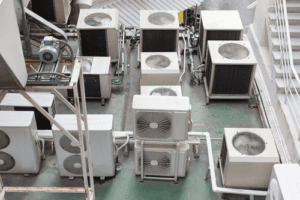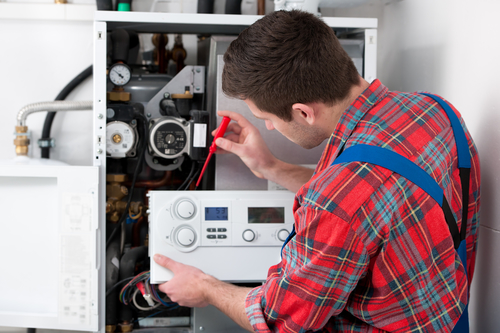No two HVAC systems are exactly alike. There are as many different systems as there are buildings to set them in, and they’re so ubiquitous that you’ll see evidence of entirely different configurations wherever you go. Nevertheless, there are specific patterns that you can find, and that boils down to a limited number of categories of commercial systems. When looking at the broad classification, the answer is that there are three major commercial HVAC system types.
What Are the Three Commercial HVAC System Types?
 There are two primary ways to determine the differences between HVAC systems. One method is to analyze where the components of the system lie and to break it into four categories on that basis, frequently used for home systems. The alternative is easier to understand and based on core functionality – what the system does. For our purposes, this is the better way to consider it, which is why we state that there are three types for commercial uses.
There are two primary ways to determine the differences between HVAC systems. One method is to analyze where the components of the system lie and to break it into four categories on that basis, frequently used for home systems. The alternative is easier to understand and based on core functionality – what the system does. For our purposes, this is the better way to consider it, which is why we state that there are three types for commercial uses.
Each of the three major types has different features and advantages. Depending on the business, the building, and the local climate, business owners may choose one type over another. To understand the differences, it’s best to consider the commercial HVAC system types side-by-side to let the contrast show plainly.
-
Single Split Commercial Cooling Systems
As the first example of the commercial HVAC system types, it’s fitting that the single split is also the simplest. There are several advantages that single split systems offer, one of them being the low purchase and installation cost. The units are designed with a one-to-one functionality so that each interior unit cooling a room is matched by an exterior unit expending hot air.
Further, these systems can be combined to cool larger rooms, meaning that businesses can gradually increase cooling capacity over time by adding units periodically. The final significant advantage is that each unit remains its own machine, so you have multiple units for multiple rooms. This benefit means that when one unit fails, you still retain most of your cooling functionality.
Naturally, there are downsides to this kind of system. While they are cost-effective and efficient, they nevertheless lack the power of central air systems. Additionally, they are room specific, so businesses may need to have numerous machines to cool a larger building with several rooms effectively. Lastly, the fact that each unit needs an external counterpart means that exterior space can prove to be in short supply, especially in urban settings.
-
Multi-Split Commercial Cooling Systems
Like single split systems, multi-split cooling systems rely on a division between interior cooling and exterior exhaust. Unlike single split systems, multi-splits allow for several cooling systems to be connected to a single exhaust unit. The immediate advantage over single splits is in the economy of space for the exterior unit. Additionally, several kinds of internal cooling units can be hooked up to the same exhaust, allowing the use of a mixture of wall and ceiling units.
On the other hand, multi-splits are more expensive than single split systems. The primary cause of this cost increase is that the piping and ventilation is more complex to install, making the initial installation and any repair work more expensive and time-consuming. Despite this, both single split and multi-split systems boast the versatility of being able to heat as well as cool rooms with an inverted system.
-
VRF or VRV System
The third primary type of HVAC system has two names: Variable Refrigerant Flow or Variable Refrigerant Volume. The terms are interchangeable and are the result of copyright law and the original patent-holders, Carrier, seeking to preserve their name, VRV.
All VRF systems are powerful machines, best suited for large commercial spaces. There are two subdivisions within this category: heat pump and heat recovery. Heat pump systems are perfect for large climate-controlled areas, such as department stores, warehouses, and bulk purchase stores. These systems provide the most potent temperature control per dollar spent and allow you to choose from either heating or cooling, but the system can only handle one of those functions at a time.
Heat recovery systems trade some raw power for increased efficiency and flexibility. By connecting the system to each room and allowing individual room controls, it is possible to effectively move heat from rooms that need to be cooled to those which need to be heated. This mobility can save tremendous amounts of money and energy over time while permitting each room’s temperature to be independently controlled.
Finding the Right HVAC System for You
Ultimately, choosing the commercial HVAC system types best suited for your business is a matter of being aware of your layout, needs, and climate. If you need the most powerful system, then focus on VRF or VRV systems. For a smaller budget, single split systems will get you up and running in the shortest time. If you are short on space, then multi-split systems ensure you can get the heating and cooling you need even in a tight fit.
Whichever system you choose, the result will be greater control over temperature and improved air quality. Your customers and employees will thank you, and eventually, your wallet will, too.


